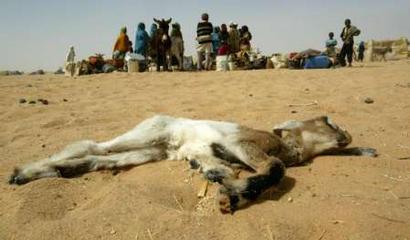Young men, others fear return home in Sudan’s west

By Nima Elbagir
ADIABEY, Sudan, Feb 18 (Reuters) – The Khartoum government says major conflict is over in west Sudan, but on Wednesday those who fled the fighting pointed to Adiabey’s charred huts and makeshift graves to explain why they fear to go home.
Amid the abandoned homes in the village, 10 decomposing corpses of young men with cloth nooses around their necks lay where they were apparently executed.
Local residents blamed Arab militia, or Janjaweed, who they said rampaged after government planes bombed in early February.
People from the area, most of whom fled across the porous border with nearby Chad, said they feared a similar fate if they returned to their villages that lie in the vast and arid Darfur region where an uprising erupted about a year ago.
The United Nations said fighting displaced up to a million people across Darfur and has warned the world of a humanitarian disaster. Access to the remote area is difficult and visits by Western news organisations are rare.
“The reason they (the Janjaweed) execute the young men is that they don’t want us to rise up against them,” said Ahmed, currently living in Chad, on a visit to his home village.
Near where Ahmed spoke laid the corpses of the young men, ranging in age from their mid-teens to 20s, some with their tongues out as if still choking for air. One had his throat slit.
African tribespeople accused the government of arming the Janjaweed, and said attacks followed a similar pattern: first come Sudanese air force Antonov planes dropping bombs, followed by marauding Arab militiamen.
Locals said 267 people from Adiabey were killed in the conflict, but the fate of the rest of the 300 to 350 inhabitants was unknown. A Reuters reporter counted about 160 graves at the village. An arm protruded from one of the dirt mounds.
In the surrounding area, three unexploded bombs, which locals said were dropped by Antonovs, lay half-buried in the ground, marked with dry thorn bushes to keep people from straying onto them.
Tensions have often flared over water and livestock in Darfur between African tribespeople, like those who live around Adiabey, and Arab herdsmen.
But the conflict escalated in February last year when rebels in the area took up arms against the government, demanding greater investment.
Sudanese President Omar Hassan al-Bashir declared major operations over in Darfur last week, but the two main rebel groups said they will continue fighting. Those who have fled said they feared the government might resume its offensive.
“How do we know it is safe to go back,” asked Ibrahim Siyam, a tribal leader from the Jerjeera area, where Adiabey is situated.
“I wanted to stay and die in my village,” he told Reuters across the border in Chad.
Sudanese Foreign Minister Mustafa Osman Ismail said on Tuesday the government would not talk directly to the rebels, but that it would hold a conference for all Darfur leaders to discuss peaceful coexistence.
The government also said it had opened “corridors” for aid to the stricken region, but the United Nations said there was still no access to most of those afflicted.
In Tina, a town straddling the Sudan-Chad border where the aid group Medecins Sans Frontieres (MSF) runs a field hospital, few of the displaced were confident about government assurances.
“Now the government say they want peace, but they just want the men that they haven’t killed to come back from Chad, so they can kill those who are left,” said one man in his 20s who declined to give his name, saying he feared reprisals from the government.
